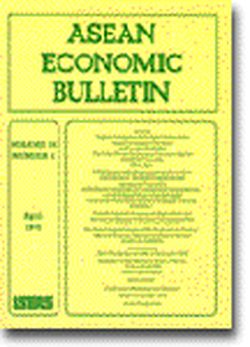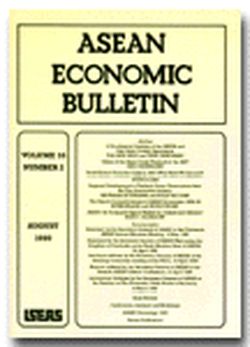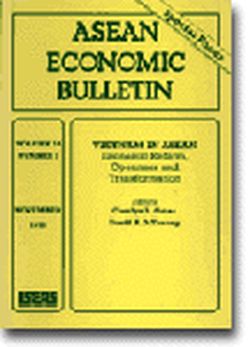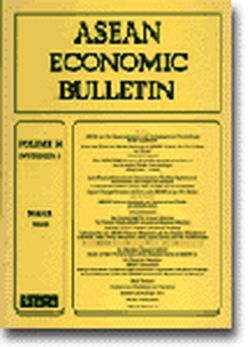ASEAN Economic Bulletin Vol. 16/1 (Apr 1999)

Date of publication:
April 1999
Number of pages:
148
Code:
AE16/1
Contents
-
Preliminary pages, by Rolf J Langhammer, author
-
Regional Integration APEC Style: Lessons from Regional Integration EU Style see abstractThis article discusses similarities and differences between past EU binding internal liberalization across the board in the industrial sector and present so-called voluntary sectoral liberalization of member states of the Asia-Pacific Economic Cooperation (APEC). While both approaches are second best compared to disconcerted unilateral liberalization, the major disadvantage of liberalization APEC style in the industrial sector consists in introducing distortions between sectors as well as between member states due to rising disparities in timing liberalization under the so-called Bogor target of achieving free trade within APEC in 2010 (2020 for less advanced member states). Reliance on peer pressure as the only mechanism to commit member states to liberalization is seen as a weak driving force to make APECs concerted unilateralism a stepping stone for the successor round of the Uruguay Round. This article proposes a number of measures successfully applied in the EU to give APECs liberalization more teeth to the benefit of multilateral liberalization.
-
The United States Anti-dumping Decisions against the ASEAN Countries see abstractAs Association of Southeast Asian Nations (ASEAN) exports to the United States increased over time, some of those countries became subject to anti-dumping duties by the United States from 1985. The cumulative proviso introduced in the Trade and Tariff Act of 1984 made the relatively smaller exporters like the ASEAN countries exposed to the anti-dumping measures of the U.S. International Trade Commission (ITC). By industry, iron and steel shared about half of the decisions against ASEAN. The percentage of the U.S. ITC Commissioners affirmative anti-dumping decisions against the ASEAN member countries was a little higher than that against the other countries. The Democrat Commissioners tended to take more affirmative anti-dumping decisions against ASEAN than the Republican Commissioners.
-
ASEAN Prospects for Regional Integration and the Implications for the ASEAN Legislative and Institutional Framework see abstractThis article serves as a potential departure point for the ASEAN Inter-parliamentary Organization (AIPO) to better come to terms with the increasingly important process of economic integration in the Association of Southeast Asian Nations (ASEAN). As ASEAN prospects for regional integration are gaining momentum in the areas of trade and investment, it is important to see how the ASEAN legislative and institutional framework could respond to such a progress of ASEAN economic integration and how AIPO could play
-
Total Factor Productivity Growth in Singapore: A Survey see abstractSince the early 1990s, discussions on total factor productivity (TFP) have become increasingly important for Singapore, and there has been substantial amounts of empirical work done in this area using both cross-country and inter-temporal analysis. This article reviews the conceptual and empirical aspects of some of the TFP growth studies on Singapore and provides suggestions for future research.
-
Causality between Government Expenditure and Revenue in Malaysia: A Seasonal Co-integration Test see abstractThe objective of this article is to empirically incorporate the effect of seasonality in examining the causal relationship between quarterly government revenue and government expenditure in Malaysia for the period 1970.1-1994.4. The seasonal integration and co-integration tests developed by Hylleberg, Engle, Granger and Yoo (1990) and extended by Engle, Granger, Hylleberg and Lee (1993) are applied prior to determination of causality. Evidence of seasonal co-integration of biannual frequency is found. The seasonal error correction model results indicate a unidirectional causal influence from government expenditure to government revenue, supporting the spend-and-tax hypothesis in the short run, i.e. higher government spending leads to higher taxes. The implication of this result is that the size and growth of the public sector and consequential tax burden as well as fiscal deficit in Malaysia are largely determined by the spending decision.
-
The Price Competitiveness of Rice Production in Vietnam: Effects of Domestic Policies and External Factors see abstractThis article develops a price competitiveness measure for Vietnam's most important crop, examines its evolution during the recent period of economic reforms, and investigates the relative importance of the following components of the observed changes in price competitiveness: (1) changes in foreign prices of rice and fertilizer; (2) changes in the real exchange rate; and (3) changes in nominal protection for rice and fertilizer. The most significant determinant of the observed decline in price competitiveness for rice during 1989-95 is shown to be the large appreciation of the real exchange rate, for which macroeconomic policies were chiefly responsible.
-
DOCUMENTATION: Hanoi Declaration of 1998, 16 December 1998
-
DOCUMENTATION: Statement on Bold Measures, Hanoi, Vietnam, 16 December 1998
-
DOCUMENTATION: Hanoi Plan of Action
-
BOOK REVIEW: The Politics of Economic Development in Indonesia: Contending Perspectives. Edited by Ian Chalmers and Vedi R. Hadiz (reviewed by H.W. Arndt)
-
BOOK REVIEW: China: The Consumer Revolution. By Conghua Li (reviewed by Zhang Zhaoyong)
-
BOOK REVIEW: Japanese Views on Economic Development: Diverse Paths to the Market. Edited by Kenichi Ohno and Izumi Ohno (reviewed by Yasutami Shimomura)
-
BOOK REVIEW: Booty Capitalism: The Politics of Banking in the Philippines. By Paul D. Hutchcroft (reviewed by Teofilo C. Daquila)
-
BOOK REVIEW: Transnational Corporations and Business Networks: Hong Kong Firms in the ASEAN Region. By Henry Wai-chung Yeung (reviewed by Kim Ong-Giger)
-
Conferences, Seminars and Workshops
-
ASEAN Chronology
-
Recent Publications






